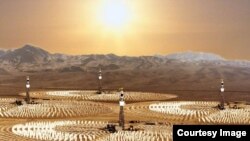The dream of using hydrogen as a clean fuel source may be a step closer to reality, according to a new scientific report.
A team of researchers at the University of Colorado Boulder say they have developed a system that would use sunlight as an energy source to split water into hydrogen and oxygen.
The method would use a vast array of mirrors that would concentrate sunlight onto a single point atop a central tower. The temperatures there could rise to as high as 1,350 Celsius. That energy would then be sent to a reactor vessel containing metal oxides, which, when heated, release oxygen atoms, according to the report in the journal Science.
That, in turn, would cause the material to seek out new oxygen atoms. When steam produced from the boiling water in the reactor vessel is added, the oxygen molecules would adhere to the metal oxide, freeing hydrogen molecules to be collected as gas, the report said.
“We have designed something here that is very different from other methods and frankly something that nobody thought was possible before,” said professor Alan Weimer in a statement. He is a member of the team that worked on the project. “Splitting water with sunlight is the Holy Grail of a sustainable hydrogen economy.”
While there are other methods to split water into hydrogen and oxygen, Colorado Boulder scientists say their method is unique because the two chemical reactions can be done at the same temperature.
“The more conventional approaches require the control of both the switching of the temperature in the reactor from a hot to a cool state, and the introduction of steam into the system,” said associate professor Charles Musgrave. “One of the big innovations in our system is that there is no swing in the temperature. The whole process is driven by either turning a steam valve on or off.”
Despite the findings, the commercialization of such a solar-thermal reactor is likely years away.
With the new method, the amount of hydrogen produced for fuel cells or for storage is entirely dependent on the amount of metal oxide -- which is made up of a combination of iron, cobalt, aluminum and oxygen -- and how much steam is introduced into the system.
The research results were published in Friday’s issue of Science.
A team of researchers at the University of Colorado Boulder say they have developed a system that would use sunlight as an energy source to split water into hydrogen and oxygen.
The method would use a vast array of mirrors that would concentrate sunlight onto a single point atop a central tower. The temperatures there could rise to as high as 1,350 Celsius. That energy would then be sent to a reactor vessel containing metal oxides, which, when heated, release oxygen atoms, according to the report in the journal Science.
That, in turn, would cause the material to seek out new oxygen atoms. When steam produced from the boiling water in the reactor vessel is added, the oxygen molecules would adhere to the metal oxide, freeing hydrogen molecules to be collected as gas, the report said.
“We have designed something here that is very different from other methods and frankly something that nobody thought was possible before,” said professor Alan Weimer in a statement. He is a member of the team that worked on the project. “Splitting water with sunlight is the Holy Grail of a sustainable hydrogen economy.”
While there are other methods to split water into hydrogen and oxygen, Colorado Boulder scientists say their method is unique because the two chemical reactions can be done at the same temperature.
“The more conventional approaches require the control of both the switching of the temperature in the reactor from a hot to a cool state, and the introduction of steam into the system,” said associate professor Charles Musgrave. “One of the big innovations in our system is that there is no swing in the temperature. The whole process is driven by either turning a steam valve on or off.”
Despite the findings, the commercialization of such a solar-thermal reactor is likely years away.
With the new method, the amount of hydrogen produced for fuel cells or for storage is entirely dependent on the amount of metal oxide -- which is made up of a combination of iron, cobalt, aluminum and oxygen -- and how much steam is introduced into the system.
The research results were published in Friday’s issue of Science.









